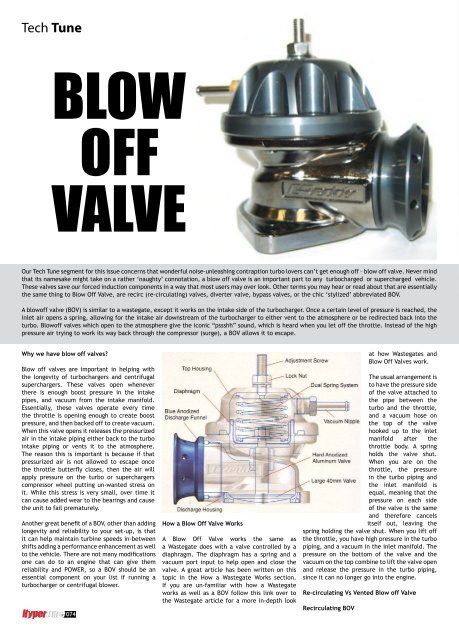Create successful ePaper yourself
Turn your PDF publications into a flip-book with our unique Google optimized e-Paper software.
Tech <strong>Tune</strong><br />
BLOW<br />
OFF<br />
VALVE<br />
Our Tech <strong>Tune</strong> segment for this issue concerns that wonderful noise-unleashing contraption turbo lovers can’t get enough off – blow off valve. Never mind<br />
that its namesake might take on a rather ‘naughty’ connotation, a blow off valve is an important part to any turbocharged or supercharged vehicle.<br />
These valves save our forced induction components in a way that most users may over look. Other terms you may hear or read about that are essentially<br />
the same thing to Blow Off Valve, are recirc (re-circulating) valves, diverter valve, bypass valves, or the chic ‘stylized’ abbreviated BOV.<br />
A blowoff valve (BOV) is similar to a wastegate, except it works on the intake side of the turbocharger. Once a certain level of pressure is reached, the<br />
inlet air opens a spring, allowing for the intake air downstream of the turbocharger to either vent to the atmosphere or be redirected back into the<br />
turbo. Blowoff valves which open to the atmosphere give the iconic “pssshh” sound, which is heard when you let off the throttle. Instead of the high<br />
pressure air trying to work its way back through the compressor (surge), a BOV allows it to escape.<br />
Why we have blow off valves?<br />
Blow off valves are important in helping with<br />
the longevity of turbochargers and centrifugal<br />
superchargers. These valves open whenever<br />
there is enough boost pressure in the intake<br />
pipes, and vacuum from the intake manifold.<br />
Essentially, these valves operate every time<br />
the throttle is opening enough to create boost<br />
pressure, and then backed off to create vacuum.<br />
When this valve opens it releases the pressurized<br />
air in the intake piping either back to the turbo<br />
intake piping or vents it to the atmosphere.<br />
The reason this is important is because if that<br />
pressurized air is not allowed to escape once<br />
the throttle buttery closes, then the air will<br />
apply pressure on the turbo or superchargers<br />
compressor wheel putting un-wanted stress on<br />
it. While this stress is very small, over time it<br />
can cause added wear to the bearings and cause<br />
the unit to fail prematurely.<br />
Another great benet of a BOV, other than adding<br />
longevity and reliability to your set-up, is that<br />
it can help maintain turbine speeds in-between<br />
shifts adding a performance enhancement as well<br />
to the vehicle. There are not many modications<br />
one can do to an engine that can give them<br />
reliability and POWER, so a BOV should be an<br />
essential component on your list if running a<br />
turbocharger or centrifugal blower.<br />
How a Blow Off Valve Works<br />
A Blow Off Valve works the same as<br />
a Wastegate does with a valve controlled by a<br />
diaphragm. The diaphragm has a spring and a<br />
vacuum port input to help open and close the<br />
valve. A great article has been written on this<br />
topic in the How a Wastegate Works section.<br />
If you are un-familiar with how a Wastegate<br />
works as well as a BOV follow this link over to<br />
the Wastegate article for a more in-depth look<br />
at how Wastegates and<br />
Blow Off Valves work.<br />
The usual arrangement is<br />
to have the pressure side<br />
of the valve attached to<br />
the pipe between the<br />
turbo and the throttle,<br />
and a vacuum hose on<br />
the top of the valve<br />
hooked up to the inlet<br />
manifold after the<br />
throttle body. A spring<br />
holds the valve shut.<br />
When you are on the<br />
throttle, the pressure<br />
in the turbo piping and<br />
the inlet manifold is<br />
equal, meaning that the<br />
pressure on each side<br />
of the valve is the same<br />
and therefore cancels<br />
itself out, leaving the<br />
spring holding the valve shut. When you lift off<br />
the throttle, you have high pressure in the turbo<br />
piping, and a vacuum in the inlet manifold. The<br />
pressure on the bottom of the valve and the<br />
vacuum on the top combine to lift the valve open<br />
and release the pressure in the turbo piping,<br />
since it can no longer go into the engine.<br />
Re-circulating Vs Vented Blow off Valve<br />
Recirculating BOV



